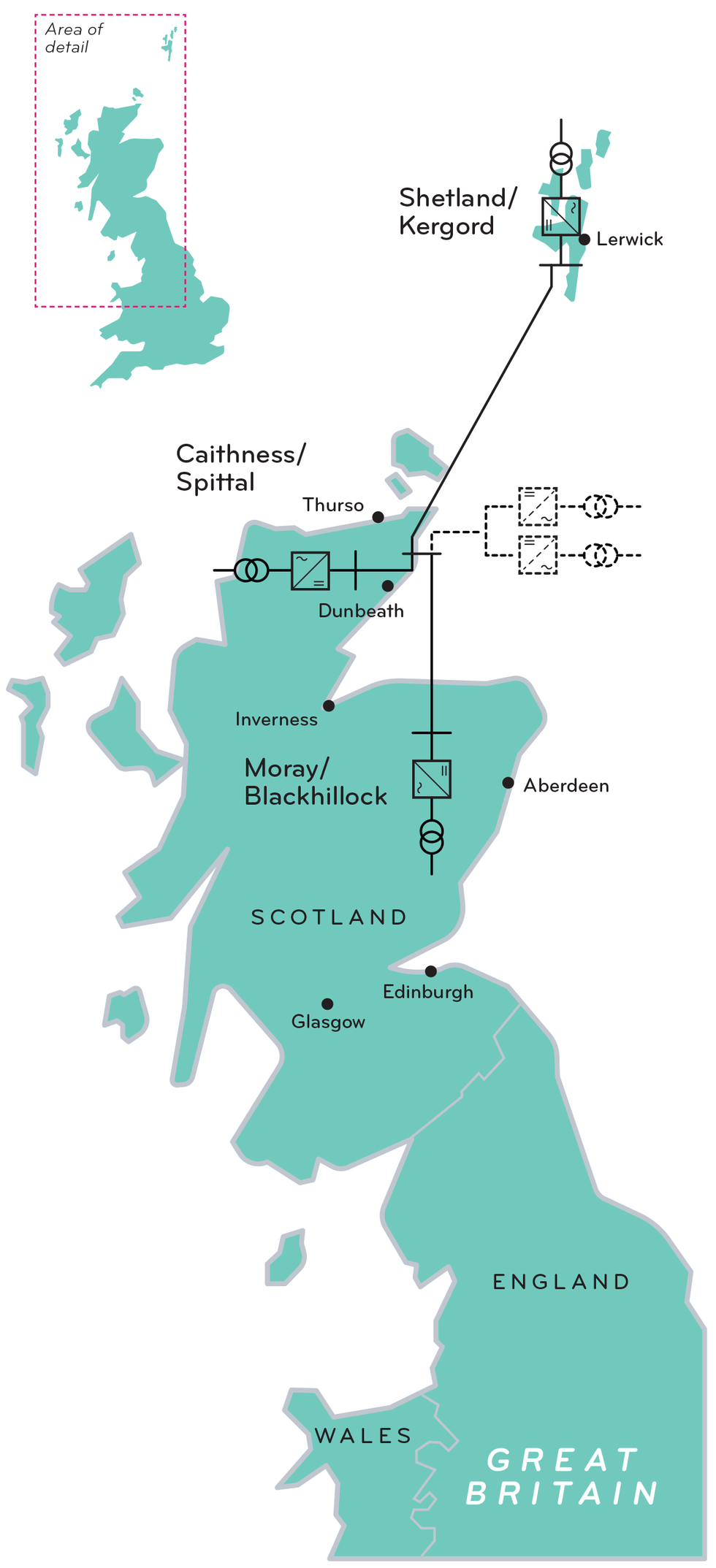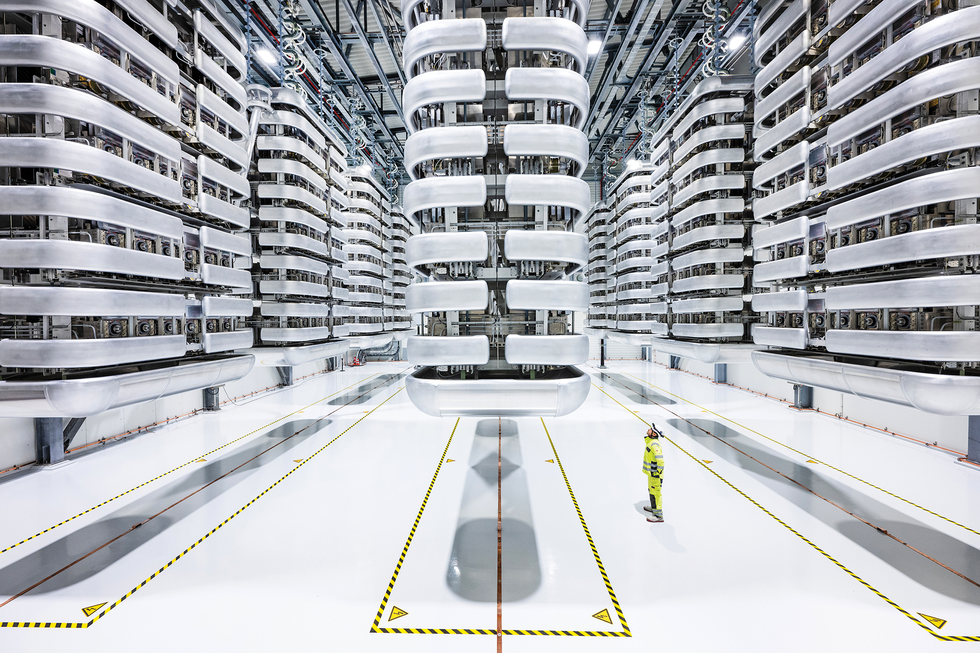The times are numbered for the Lerwick Energy Station, whose diesel mills have equipped electrical energy to the Shetland Islands for over 70 years. Beginning across the center of 2024, the Shetlands—and likewise a part of mainland Scotland—will probably be powered by the 443-megawatt Viking wind farm, consisting of 103 wind generators on the principle island of Shetland.
However what’s most attention-grabbing in regards to the mammoth, £580 million mission isn’t a lot the generators because the subsea transmission hyperlink that may join the wind farm to the Scottish mainland. Peak demand within the Shetlands is simply about 44 MW, so at any given time as a lot as 90 p.c of the Viking output might stream south through the hyperlink. The 260-kilometer, 320-kilovolt high-voltage direct-current (HVDC) transmission system, primarily based on know-how from
Hitachi Power, in Zurich, marks a milestone in an ongoing transformation of the European energy grid: It is going to plug into the primary really dynamic multiterminal HVDC community in Europe.
This newer HVDC know-how is opening up new alternatives. “European grid operators are adopting HVDC because the know-how of selection for his or her bulk-transmission wants sooner or later,” says
Cornelis Plet, vp for DNV, a consultancy that advises on energy techniques and threat administration.
In accordance with Plet, wind power is driving an acceleration of HVDC installations in Europe. By 2030, the European Union seeks to roughly double, to 42.5 p.c, the share of power met by renewables. Officers are prioritizing tasks that faucet the comparatively constant and robust winds that blow farther offshore, greater than 75 km, say—a distance for which the excessive capacitance of insulated energy cables renders AC transmission impractical. Grid operators are additionally putting in subsea DC interconnections in different areas to share wind-energy surpluses and hook up with backup provides, comparable to Scandinavia’s large hydropower reservoirs. Moreover, subsea and underground HVDC cables more and more seem like essentially the most viable option to push added wind energy throughout congested nationwide grids and densely populated landscapes.
New Expertise Drives an HVDC Renaissance
Driving this enlargement in HVDC are main technical advances. Traditionally, HVDC strains conveyed energy from one single level to a different. The extent of energy switch wanted to be set, and its route couldn’t be instantaneously reversed—as can be vital if the strains have been a part of a community. Nevertheless, beginning round 25 years in the past, the trail to multiterminal HVDC techniques was established by large enhancements within the converters that change high-voltage alternating present to DC, and vice versa.
 Energy generated by the443-megawatt Viking wind farm, within the Shetland Islands, will feed a 3 terminal HVDC community, with the opportunity of two extra terminals sooner or later. The southern most terminal is at Blackhillock, Scotland, the positioning of Europe’s second-largest substation.Elias Stein
Energy generated by the443-megawatt Viking wind farm, within the Shetland Islands, will feed a 3 terminal HVDC community, with the opportunity of two extra terminals sooner or later. The southern most terminal is at Blackhillock, Scotland, the positioning of Europe’s second-largest substation.Elias Stein
The important thing advance was the implementation of voltage-source converters (VSCs). Amongst different options, they permit operators of a transmission line to independently management not solely the actual energy flowing on a line, but additionally the
reactive energy, which is the product of the voltage and the present which might be out of part with one another. One other characteristic of the brand new techniques is modularity: Most fashionable VSCs are carried out as an built-in set of modules, in a system referred to as a modular multilevel converter (MMC).
The converters are made up of submodules, and the upper the voltage being transformed, the better the variety of submodules. These submodules, in flip, are sometimes primarily based on capacitors and high-speed insulated-gate bipolar transistors. Power from the AC supply is saved in DC capacitors within the submodules. The capacitors are then charged and discharged in sequence to alternate power with the AC community.
The Shetland hyperlink will create a three-terminal system by including on to an current HVDC cable additional south. From the Shetland HVDC converter station, close to the wind farm, DC is transmitted through the subsea cable to an current converter station, close to the cable’s landfall on Scotland’s northern tip. An inverter there can feed into the mainland AC grid. Or the DC energy coming from the island can bypass that first mainland converter, persevering with south to a 3rd converter station that’s 160 km nearer to Scotland’s big-city shoppers. Or the system’s controller can flip the whole sport plan, sending electrical energy north to Shetlands shoppers simply as shortly as its winds can shift.
What makes that dynamic energy juggling doable is the versatile management over present and voltage that’s the hallmark of VSC know-how. Over the previous three many years, China
pushed conventional HVDC know-how, primarily based on present supply converters and thyristors, to large scale to ship hydro, coal, and wind energy hundreds of kilometers to its coastal industries and megacities. To take action, engineers needed to construct the world’s most sturdy AC networks, together with big quantities of reactive-power compensation and a whole lot of filtering to forestall harmonic suggestions.
VSC is a basically completely different know-how, pioneered within the late Nineties at Swiss-Swedish engineering large ABB, whose power-grid enterprise was
not too long ago acquired by Hitachi Power. Not like the normal current-source converters, VSCs can regulate their very own voltage. Which means they may also help stabilize the AC networks they commerce energy with. That characteristic gave ABB’s VSC-based techniques an prompt area of interest the place there was actually no AC grid to lean on: sending electrical energy ashore from distant wind farms.
The know-how caught a tailwind in 2010 when ABB’s main HVDC rival, Siemens, commercialized the modular design that has since swept the market. Siemens’s MMC submodules swap solely as soon as per AC cycle, slicing losses from about 1.7 p.c to 1 p.c per converter. MMCs at the moment are the usual configuration and are utilized in the UK’s
latest offshore wind farm, off the coast of Yorkshire, which has 1,080 submodules and started delivering energy in October.
European grid operators have deployed about 50 gigawatts of VSC-based HVDC know-how to this point. One other 130 GW is deliberate for the continent over the subsequent 10 years, in response to a
September 2023 report that Plet cowrote for a U.S. grid analysis and advocacy consortium.
Europe and China Race for “Meshed” Grids
To this point, Germany has essentially the most formidable program. A trio of HVDC techniques will take wind energy coming from offshore into northern Germany and transfer it inland to southern Germany. However way more HVDC transmission capability will probably be wanted to accommodate an anticipated surge in offshore wind. For instance, Dutch-German grid operator TenneT not too long ago signed €30 billion (US $33 billion) in contracts for 14 units of converters and subsea cables to be working by 2031—some in Germany and the remainder within the Netherlands. That scale is slicing prices and rushing supply by serving to its distributors—GE Renewable Power, Hitachi, and Siemens—finance capability expansions.
Germany has additionally led standardization, with an eye fixed to expanded DC grids down the road. TenneT requested all of its suppliers to supply suitable 525-kV HVDC techniques with room for additional switchgear, creating the choice to interconnect at present’s segments in bigger networks.
Different European states have joined the rising 525-kV commonplace. The UK’s audacious community plan specifies a dozen 525-kV offshore wind hyperlinks that its electrical energy system operator deems vital by 2030. Amongst them is a doable five-terminal system linked end-to-end astride the North Beach—to reduce each the converter stations bought and the cable crossings and landfalls dug throughout delicate coastal ecosystems. As well as, the U.Ok. plans to push its rising wind harvest south towards London through six extra offshore HVDC cables, working shore-to-shore like patch cords in an old-time phone switchboard.
In 2020, Chinese language utility large State Grid began up the world’s first meshed DC grid—a four-node, 500-kV ring close to Beijing
Finally, European grid planners foresee a day when at present’s HVDC tasks interconnect to type a meshed DC community stretching throughout the North Sea and past. That can require one thing additional: an HVDC circuit breaker able to almost instantaneous operation at 525 kV.
Reducing off AC energy is extra easy as a result of its voltage zeroes out each time the present reverses route. HVDC techniques presently exploit that zero-crossing to deal with faults, utilizing AC breakers to energy down the converters and thus squelch the continual present flowing between them. However converter stops and restarts will probably be too disruptive to giant HVDC networks. “Whenever you go to 4 or 5 terminals, the system turns into too large to close down,” says
Andreas Berthou, Hitachi Power’s group senior vp and international head of HVDC.
In 2020, Chinese language utility large State Grid began up the world’s first meshed DC grid—a four-node, 500-kV ring close to Beijing full with 16 proprietary HVDC breakers. However Western sources say there’s been no unbiased evaluation of its operation.
All the large HVDC suppliers are engaged on circuit breakers. Hitachi Power’s proprietary unit has been verified at 350 kV, and Berthou says it’s being thought of for “a pair” of offshore tasks. “We’re able to tender at 525 kV,” he claims.
 An HVDC converter corridor at an undisclosed location is outfitted with Hitachi Power’s Voltage Supply Converter know-how, primarily based on modular, multilevel converters. Hitachi Power
An HVDC converter corridor at an undisclosed location is outfitted with Hitachi Power’s Voltage Supply Converter know-how, primarily based on modular, multilevel converters. Hitachi Power
One in every of Germany’s cross-country HVDC tasks will exhibit an alternate method: an MMC converter design with “full-bridge” modules able to opposing and stopping gigawatts of DC energy. The fee: twice as many expensive, power-consuming insulated-gate bipolar transistors per module.
Meshed HVDC grids appear to be science fiction in a U.S. grid context—dwelling to simply 3 p.c of contemporary HVDC installations, in response to Plet’s report. However a number of states have plans to observe Europe’s HVDC lead. New Jersey chosen a system of HVDC hyperlinks to attach its first offshore wind farms, for instance, and California is contemplating an offshore HVDC “patch twine” to spice up its north-south energy flows.
However securing the tools received’t be simple, in response to consultants.
Emmanuel Martin-Lauzer, a U.S. business-development director for Paris-based cable producer Nexans, not too long ago likened Europe’s mission pipeline to a “black gap” devouring the world’s provide of HVDC cable.
Plet says some U.S. transmission builders have put down “tens of hundreds of thousands of {dollars}” to safe a spot in manufacturing queues—a “large threat” since poorly coordinated state and federal grid-approval processes kill off many tasks. Builders may even pay dearly to employees up, he says, given the dearth of U.S. electrical engineers with HVDC experience. Including it up, Plet figures that U.S. HVDC improvement could lag Europe’s by a decade.
This text seems within the January 2024 print problem as “Excessive-Voltage DC Energy Roars Ashore in Europe.”
From Your Web site Articles
Associated Articles Across the Internet